EMIR Commissioning Report (DRAFT Version 0.1, May, 7, 2009, CK)
Contents
The Commissioning team: Juan Penalver, Hans Ungerechts, Helmut Wiesemeyer, Albrecht Sievers, Gabriel Paubert, Walter Brunswig, Guillermo Quintana-Lacaci, Denise Riquelme, Rebeca Aladro, Breezy Ocana, Manolo Ruiz, Melanie Krips, Sascha Trippe, Dirk Muders, Albert Greve, Clemens Thum, Karl Schuster, Carsten Kramer
Here, we report on the results of the commissioning of the new Eight Mixer Receiver at the IRAM 30m telescope, which were conducted between end of March and end of April 2009.
Related documents:
EmirHWinstallDraft001.pdf EMIR Installation report by Jean-Yves Chenu, A.L. Fontana, B.Lazareff, P.Pissard, D.John, J.Penalver, and Santiago Navarro
- EMIR receiver characterization in the laboratory by A.L.Fontana (3/2009)
Continuum Observations
Continuum backends
At present, only the central 1GHz of each 4GHz chunk are being used for continuum detection. Broad band 4GHz wide continuum detectors are in preparation.
Nasmyth Offsets
EMIR has two beams seperated by 90arcsec on the sky. Several pointing sessions were conducted to determine the Nasmyth offsets to be -39.0"/+5.5" for the left beam and +51.0"/+5.5" for the right beam. Each pointing session consists of observations of several dozen of point sources distributed over the sky. The left beam is used for most EMIR setups, i.e. for single band E0 or E2 observations, and for dual band E0/E2 and E0/E1 observations. The right beam is used for E1, E3, E1/E3. At present, the observer has to set the Nasmyth offsets in PaKo. They are not yet set automatically when switching the EMIR setup.
Alignment

The above figure shows the alignment between the four EMIR bands and between the two polarisations of each band. The overall alignment is better than 1 arcsec.
Foci
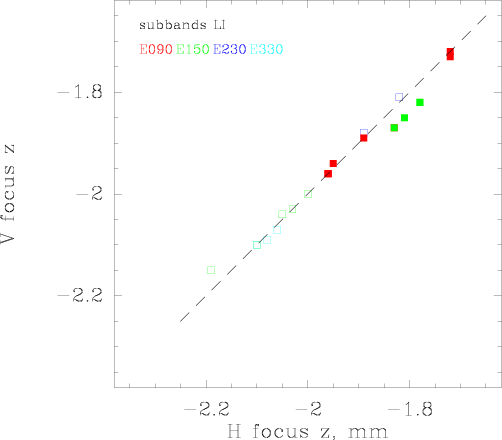
The above figure shows the focus between different polarisations of the same band. There are no significant differences between these foci.
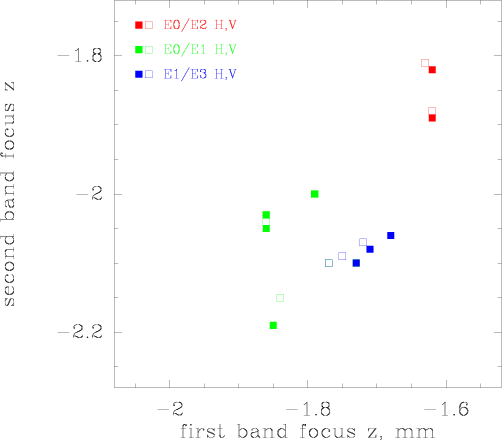
This figure shows the focus between different bands. The largest deviation is about 0.3 mm, similar to the situation with the ABCD receivers. For dual band observations, the telescope should be focussed to the high frequency band.
We also made focus scans in lateral (x, y) directions, however, with inconclusive results. The observed telescope efficiencies indicate that the telescope is well focussed.
Telescope Efficiencies
Freq
HPBW
Feff
Beff
Aeff
S/TA*
Comments
GHz
arcsec
%
%
%
Jy/K
86
29
95
81
63
5.9
4.4.
145
16
93
62
57
6.4
4.4.
210
11
95
29.3.
260
9
89
29.3.
330
7
89
32
29
12.0
4.4.
The main beam and aperture efficiencies, and the beam widths, were derived from Mars observations. The observations on April, 4th, were conducted at an elevation of 43 deg, i.e. near the maximum of the gain elevation curve. The observations on March, 29th, were conducted at elevations between 29deg and 44deg. The ellipticity of the beams is better than 90% in all cases. Mars was pointlike with a diameter of 4arcsec.
The forward efficiencies were derived from Skydips. All skydip observations conducted in the week before Apr, 1st, resulted in the following efficiencies:
band
freq.(GHz)
Feff
E0
96, 98
0.95
E1 (with E0)
147
0.92
E1 (with E3)
145, 147
0.95
E2
210, 231
0.95
E2
260
0.89
E3
330
0.89
The analysis of the skydips was done manually. The atmospheric temperature Tabm used is 0.94xTamb, with the ambient temperature Tamb. Only two fits at 330GHz were done using 0.96xTamb. The agreement between the atmospheric opacity derived from the skydips and those determined by the standard (chopper-wheel) calibration, agree very well. At present, it is not clear whether the slight 3% difference in forward efficienciers found between observations with band E1 together with E0, or together with E3, i.e. with different dichroics, is significant or not.
Test observations of sources from the flux monitoring catalogues
to be written
Spectral line observations
Spectrometers
During commissioning, we used the 4MHz filterbank and the two auto correlator backends WILMA and VESPA, partly in parallel. A variety of VESPA setups were checked, covering the range of resolutions between 3kHz and 1.25MHz and a wide range of bandwidths. VESPA parallel mode was also checked. However, it is not possible to check all possible setups. The 1MHz filterbank has not yet been commissioned.
Observing modes
The following switching modes were re-commissioned: position switching (onoff), wobbler switching, and frequency switching. Beam switching was checked using the continuum backends. The on-the-fly mapping mode was re-commissioned, in combination with position switching and with frequency switching.
EMIR setups
The following EMIR setups were requested in the proposals for this summer semester and have been commissioned. The Code corresponds to the table created by S.Navarro describing possible setups of the switch box. The listed Bandwidth is the total bandwidth covered by the resulting spectra, given to about 0.5GHz accuracy.
Band(s)
Sidebands
Polarisations
Bandwidth
Code
E0
1SB
H/V
8GHz
(13)
E0
2SBs
one pol.
16GHz
(14)
E0/E1
1SB
H/V
8GHz
(121)
E0/E2
1SB
H/V
8GHz
(131)
E0(8GHz)/E2
1SB
mixed
12GHz
(135)
E1
1SB
H/V
4GHz
(2)
E2
1SB
H/V
4GHz
(3)
The following Figure shows the frequencies of the band edges and centers of the lower and upper sidebands, and the inner and outer bands. Note that the band edges and center are not exactly at multiples of 2GHz relative to the local oscillator. This is due to the IF distribution. The backends are centered near the band centers. VESPA is centered at 6.25 or 9.43GHz. For WILMA, the inner and outer bands have 0.1GHz overlap. The inner band runs from 4.125 to 7.845GHz. The outer band runs from 7.835 to 11.555GHz.

Band Edges
- We tuned the lower outer band of the 3mm receiver to a center frequency of 78GHz, without difficulties. The receiver noise temperature rises to ~200K at the band edge near 76GHz. This setup allows to observe e.g. the N2D+(1-0) or the DNC(1-0) transitions. Trying to tune to still lower frequencies, the receiver temperature rapidly rises to several 1000K.
The following image shows a spectrum of IRC+10216 taken at 78GHz.
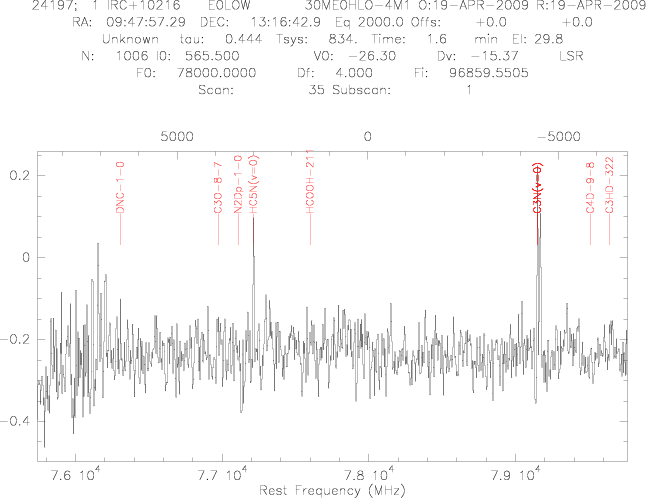
Ripples and spurious signals
to be written
System Stability
to be written
Science verification
- The following figure shows a spectrum of Orion IRc2 covering 32GHz of the 3mm window. It was taken with WILMA in wobbler switched mode in two EMIR setups in 30minutes of on+off observing time. Each EMIR setup used 16GHz simultaneously, both sidebands, with one polarisation. One broken WILMA unit was later repaired. The 4MHz/8GHz Filterbank was used in parallel, but data are not shown here.
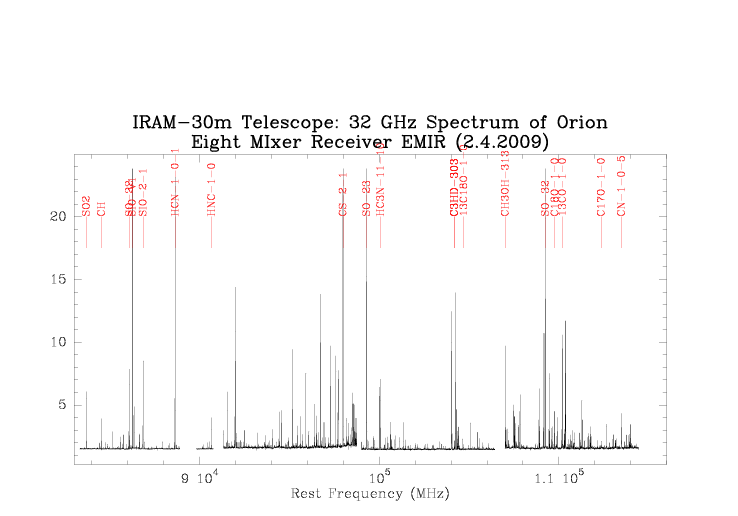
- A long 4 hour integration of the Cloverleaf, a quasar at high redshift, in the 3mm window, resulted in flat baselines with 0.4mK at 150km/s resolution. For this, we used WILMA in wobbler switching mode. The redshifted CO 3-2 line is confirmed.
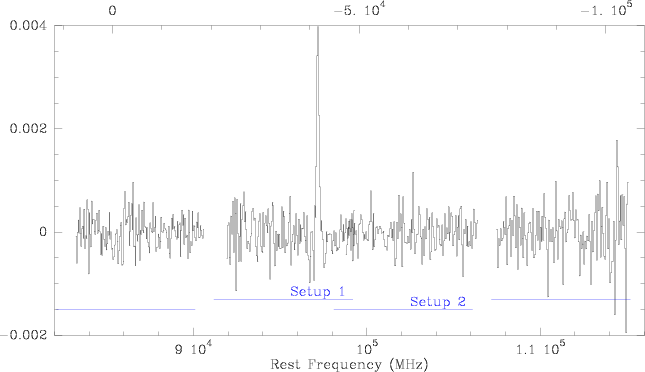
Next steps
- The 1MHz filterbank is not yet available
- HERA needs to be tested before being available again
- Polarimetry will be commissioned later
- Band 4 will be fully commissioned later and is in general not available this summer semester.
A PaKo manual is in preparation. PaKo online help on new EMIR features is already available.
